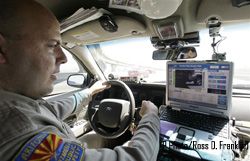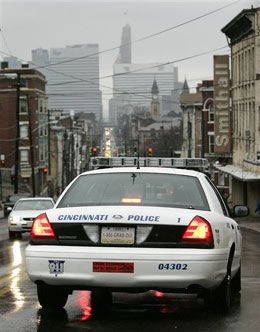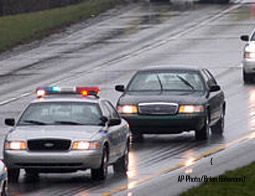By Rachel Fretz
If you’re a typical patrol officer, you could be spending up to 12 hours a day in your vehicle. While you may feel like you’ve got driving down pat, the staggering number of traffic-related officer deaths in 2007 – 56 to date – tells a far different, and very grim story.
Here, driving experts offer their best training tips on how to avoid collisions, increase your safety on the roads and get you home alive.
 Talking on your cell phone or radio while driving is a form of impairment. These dashboard distractions can be deadly. |
Do not underestimate the influence of distractions
You would never drink and drive, yet multitasking — talking on your cell phone or radio while driving — is also a form of impairment. Underestimating the influence of these distractions can be deadly.
Law enforcement driving expert and P1 columnist Captain Travis Yates of the Tulsa (OK) PD explains:
“If an officer is distracted from the roadway, it can have disastrous consequences.
“At 60 mph, when you include reaction time and braking, it takes 300 feet (or a football field) to stop a car. If you add wet roads, poor reaction time or poor tire tread, that distance increases. Imagine being distracted for just a few seconds by looking at a computer screen or answering the radio.
“The car is travelling at 88 feet-per-second. If you look up after a second or two of distraction and a hazard is in front of you, it may be impossible to stop. If you add in darkness and the limited view with the headlights, these dangers increase.”
While the realities of the job require officers to communicate from their vehicles, you can minimize the dangers by making the calls at a traffic light, in a parking lot, or while pulled over.
“We can’t write an unrealistic policy concerning these necessary communications tools,” said Yates, “so we have to choose the best option possible. Not overestimating your multi-tasking ability is a good place to start.”
“Cover the brake” at intersections
 |
“Even if the light is green,” Yates said, “that doesn’t mean you’re 100% protected to go.”
Practice when/then thinking and mental imagery to prepare to respond to events that occur on the roadway.
Getting complacent behind the wheel? Use your downtime to rehearse worst-case scenarios.
Brian Willis, President of Winning Mind Training in Calgary, Canada, is a big proponent of when/then (or “mental rehearsal”) drills for driving scenarios. This entails visualizing the answer to the question, “What am I going to do when ____ happens?”
“If officers get caught without a plan at the subconscious level, they don’t have enough time consciously to make a decision and take safe, evasive action,” he said.
Willis says “avoidance behavior,” or startled reflex reactions, can hurt more than they help.
“When officers do take evasive action, it tends to be in the form of very jerky movements on the steering wheel or extreme movements on the brakes, and that’s what very often makes them lose control of the vehicle,” said Willis.
“When/then thinking will help keep your stress level down, which is conducive to enhancing your ability to function in those scenarios.”Practice autogenic, or “combat”, breathingWe know that oxygen keeps us alive, so why do we forget to breathe in stressful moments when our brain needs it the most? When we tense up, we forget to breathe and our systems shut down.
“One very dangerous symptom of stress is loss of peripheral vision,” said Willis. “When officers are in high–stress situations, they experience tunnel vision, ‘visual narrowing’ that reduces their ability to see other vehicles approaching.” The best tool an officer has to reduce this effect is “combat breathing.”
“Oxygen will reverse this physiological effect at the source,” he said. “Whoever is on the radio with the officer, whether it be a supervisor or dispatcher, can walk an officer who is experiencing these effects through the breathing exercise.
“When the supervisor hears that stress in the officer’s voice, he can say to him, ‘I need you to take a deep breath and give me this information, then take another deep breath and tell me this,’ and so on.”
Breathing techniques can be a staple of when/then thinking, and should be a part of emergency response driver training. (More on tactical breathing.)
Scan using the 2-Second Rule
When it comes to driver safety, reaction is the key to everything. And in order to react, you must be able to anticipate. Unfortunately, many officers, after spending hours behind the wheel, fall into a trancelike state and experience “tunnel vision.”
“If you have tunnel vision—if you’re only looking right beyond your hood—and something happens 400 feet down the road, you won’t have time to react,” Yates said.The trick, he says, is to move your eyes every two seconds using what’s called ‘scanning,’ a technique that is taught in firearms training.
“Scan ahead as far as you can see,” Yates said. “If you can look 15 seconds ahead, you will be prepared for anything that may come your way.”
In addition to scanning ahead, Yates also advocates checking your mirrors every 5 to 8 seconds, which is the easiest way to manage all four sides of your vehicle. “Conditions will change rapidly based on what is happening around you,” he said.
Manage your vehicle spacing
Almost every safe driving text will discuss spacing (how much space is between your car and the cars around you). The reason for this is simple, said Yates.
“The less spacing between cars means the less room for error for everyone around,” he said. “When something bad happens in front of an officer, they need the chance to either stop or avoid the problem, Without the proper spacing, it is impossible to do.”
Spacing increases visibility, and with visibility, you create time: time to react, time to avoid a collision and time to stop.
A four-second following distance needs to be maintained in ideal conditions. If the conditions are not ideal, such as wet roads or emergency driving, that distance should be increased.
“The easiest way to determine the following distance is to look at a fixed object that the car ahead passes and count the seconds it takes your vehicle to pass it,” Yates said.
Check your tire pressure
 |
Pressure in a tire can go up in warm weather and down in cold weather as much as two pounds for every 10 degrees of temperature change. Even if the temperatures are constant, air will escape through tires at a rate of approximately 1-2 pounds per square inch (psi) per month.
Over- or under-inflation of a tire can be very dangerous. A tire can be as much as 50% under-inflated and still appear normal, so a tire gauge should be used. The manufacturer of your police vehicle or your garage can advise you of the proper tire pressure.
Think twice before speeding
How many calls do you rush to, only to find the speed was unnecessary?
“Some of the calls we’re getting killed on are calls we maybe shouldn’t be hustling to,” said Craig Stapp, a training sergeant with the City of Tempe (AZ) PD.
Driving at a normal rate is dangerous enough. The danger level in speed increases dramatically. When you double your speed, it doesn’t just double your stopping distance - it quadruples it.
“It’s a mindset,” Stapp said. “You need to slow down, take a breath, and weigh the risks we’re willing to expose ourselves to. Part of that is decision-making – the same thing you apply to use-of-force.”
Adjust your speed before curves
“It’s always better to enter a curve a little too slowly than too quickly,” said Yates. “So slow down before you enter a curve.”
“Once you start turning the wheels you can’t hit the brakes without increasing the odds of losing control of the vehicle.”
Yates suggests practicing what’s called “straight-line braking:”
“Brake and get that speed off when your wheels are going straight,” he said. “You can always accelerate coming out of a curve as you enter into a straight line, but you’re stuck with the momentum you enter with.” (Caution: Do not attempt straight-line breaking without first practicing in a controlled training environment)
Also, said Yates, “Use the entire lane as you negotiate the curve. There is no reason to fight your car and lose control because you are staying at the same place in the roadway.”
Don’t fall prey to “siren syndrome”
“A lot of officers get ‘siren syndrome,’” said Yates. “Meaning when they’re in the car using lights and siren, they feel invincible. But driving with this false sense of security can get you killed.”
The average motorist driving along with the radio on doesn’t notice an emergency police vehicle until it is right beside or behind him.“It may feel loud and real to you, but other motorists are obstructed by factors like hills, wind, and the radio, that will drown you out,” said Yates.
The only way to combat that is training, he said. “If we show officers that other drivers don’t know they’re coming, that officer will change his behavior.”
TRAIN, TRAIN, TRAIN
How often do you go back to do in-service driver training? This varies from department to department. While training can be expensive, no dollar amount can be put on officer safety.
The volume, type and realism of the training you receive will determine how deftly you are able to anticipate and respond to your roadway environment.
And while any training is better than no training, there needs to be some significant thought as to what type of training program is implemented.
“The best way to do this is to gather and analyze the data of the collisions occurring at the agency,” said Yates.
While the resources may not be there to train the entire department, the data may show that officers with less than five years of service are having the majority of collisions. This is a great way to start a program: start it with those most at risk and expand it as you see that early success.
Training should be in focused areas where specific problems are happening. Those problems may change each year and the skills taught will certainly diminish each year. That is why Yates advocates regular training on a yearly basis.
“We are seeing this more and more around the country,” he said. “Agencies are recognizing that the basic training in the academy is not enough. To keep their officers safe, that training needs to continue well into an officer’s career.”
Capt. Travis Yates explains how to start a driver training program.
Using when/then thinking to avoid a collision
Roadside Safety: 10 tips you can’t hear often enough


